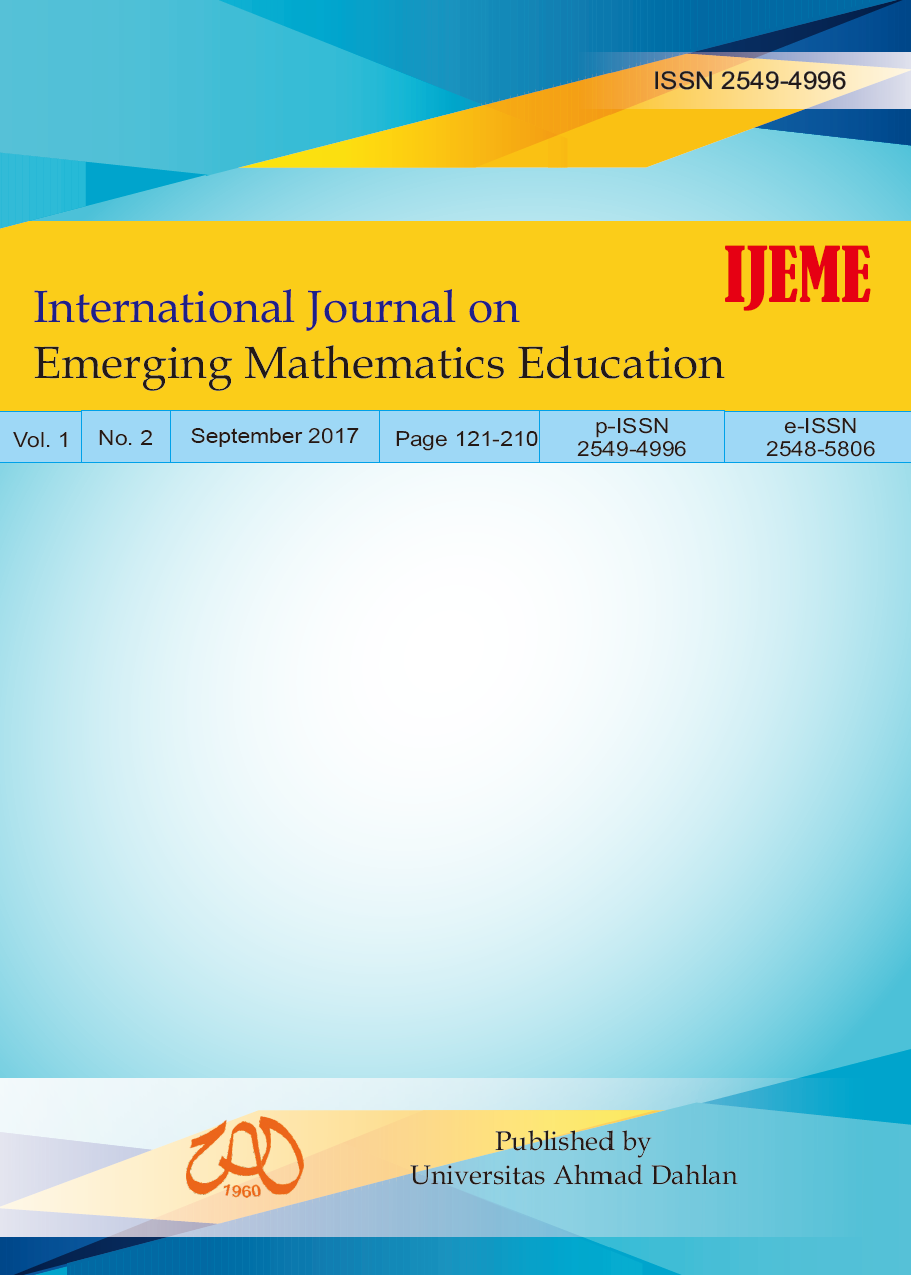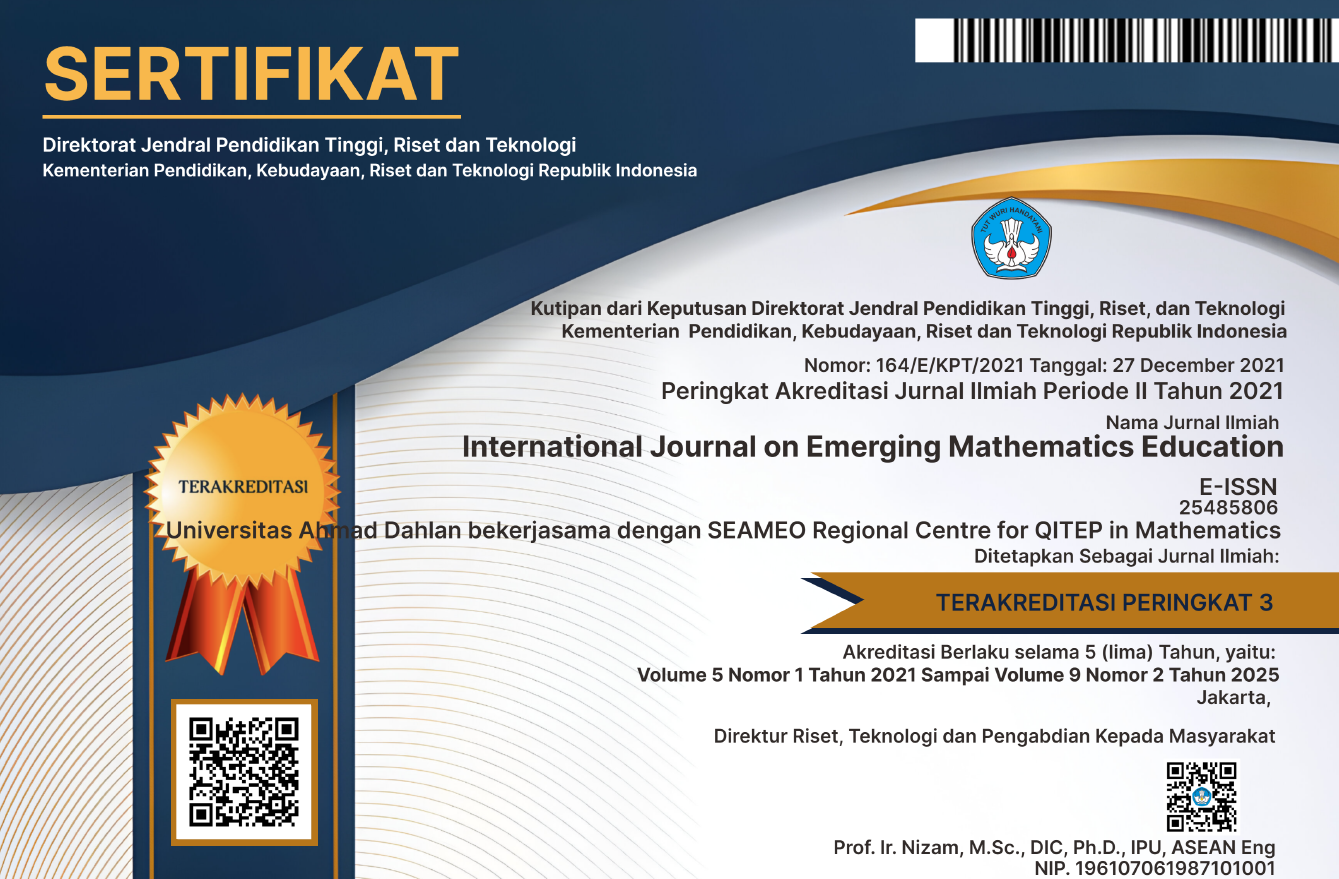Images of Mathematics Held by Undergraduate Students
DOI:
https://doi.org/10.12928/ijeme.v1i2.6647Keywords:
Images of mathematics, nature of mathematics, symbolic violence, pedagogical approach, qualitative researchAbstract
The purpose of this study was to explore images of mathematics held by undergraduate students and possible influencing factors. The image of mathematics in this study was conceptualized as the mental representations or views of mathematics as undergraduate students experienced during their academic journey through the interaction largely at school. Pierre Bourdieu's construct of symbolic violence served as the theoretical lens to evaluate the students' images of mathematics. The design of this study was explorative qualitative and interpretive. Semi-structured interview was used to generate data texts from three participants who were senior undergraduate students studying mathematics at an affiliated college of Tribhuvan University in Kathmandu. From the thematic analysis and interpretation of the textual data, four common themes emerged as images of mathematics held by the participants. These themes were mathematics as difficult and abstract, as decontextualized, as mysterious subject, and as applicable in different fields. The influencing factors on the formation of these images were largely related to the curricular and pedagogical approaches from schools to university classes. These are conventional and disempowering methods of teaching, decontextualized curriculum and textbooks and other teaching learning resources, medium of instruction and nature of mathematics itself.
References
Awasthi, L.D. (2004). Exploring the monolingual school practices in multilingual Nepal. Unpublished Doctoral Dissertation, Danish University of Education, Copenhagen, Denmark.
Belbase, S. (2006). My journey of learning and teaching mathematics from traditionalism to constructivism: A portrayal of pedagogical metamorphosis. M.Phil. Dissertation, Kathmandu University, Nepal.
Belbase, S. (2013). Image, anxieties, and attitudes toward mathematics. International Journal of Education in Mathematics, Science and Technology, 1(4), 230-237.
Belbase, S. (2015). Preservice secondary mathematics teachers' beliefs about teaching geometric transformations using Geometer's Sketchpad. PhD Dissertation, University of Wyoming, Laramie, Wyoming, USA.
Belbase, S. (2016). Reflective and reflexive beliefs of two pre-service secondary mathematics teachers. European Journal of Educational and Social Sciences, 1(1), 34-65.
Belbase, S. (2017). Attitudinal and cognitive beliefs of two pre-service secondary mathematics teachers. International Journal of Research in Education and Science (IJRES), 3(2), 307-326.
Beswick, K. (2007). Teachers' beliefs that matter in secondary mathematics classrooms. Educational Studies in Mathematics, 65, 95-120.
Bourdieu, P. & Passeron, J.C. (1990). Reproduction in education, society and culture. (Nice, R. Trans.). London: Sage Publication.
Bourdieu, P. (1991). Language and symbolic power. (Raymond, G. & Adamson, M. Trans.). UK: Polity Press.
Bourdieu, P. (1995). Outline of a theory of practice. (Nice, R. Trans.). Cambridge: University Press.
Cohen, L., Manion, L., & Morrison, K. (2007). Research methods in education (6th ed.). USA and Canada: Routledge.
Creswell, J.W. (2007). Qualitative inquiry and research design: Choosing among five approaches (2nd ed.). New Delhi: Sage Publications.
Creswell, J.W. (2012). Educational research: Planning, conducting and `evaluating quantitative and qualitative Research (4th ed.). Boston: Pearson.
Ernest, P. (1991). The philosophy of mathematics education. UK: Routledge Falmer.
Ernest, P. (1994). The dialogical nature of mathematics. In Ernest, P. (Ed.). Mathematics education and philosophy: An international perspective. UK: The Falmer Press.
Ernest, P. (1998). Social constructivism as a philosophy of mathematics. USA: State University of New York Press.
Ernest, P. (2008). Epistemology plus values equals classroom image of mathematics. Philosophy of Mathematics Education Journal, 23, 1-12.
Ernest, P. (2012). What is our first philosophy in mathematics education? For the Learning of Mathematics, 32(3), 8-14.
FitzSimons, G.E. (2002). What counts as mathematics? Technologies of power in adult and vocational education. Netherlands: Springer.
Freire, P. (1973). Education for critical consciousness. New York: Continuum.
Giroux, H. (1992). Border crossings: Cultural workers and politics of education. New York: Routledge.
Goodwin et al. (2014). Exploring the relationship between teachers' images of mathematics and their mathematics history knowledge. Philosophy of Mathematics Education Journal, 28.
Grenfeel, M., & James, D. (1998). Bourdieu and education: Acts of practical theory. UK: Falmer Press.
Hersh, R. (1997). What is mathematics really? New York: Oxford University Press.
Howse, M. (2006). What is the nature of African American teachers' beliefs about mathematics and how do this` belief relate to their beliefs about African American mathematics students? Unpublished Doctoral Dissertation, College of Education, the Florida State University, USA.
Jackson, E. (2008). Mathematics anxiety in students' teacher. Practitioner Research in Higher Education, 2(1), 36-42.
Kathmandu University and UNESCO Office in Kathmandu. (2008). Developing culturally contextualized mathematics resource materials: Capturing local practices of Tamang and Gopali communities. Lalitpur, Nepal: UNESCO Office in Kathmandu.
Kloosterman, P. (2003). Beliefs about mathematics and mathematics learning in the secondary school: Measurement and implication for motivation. In G. C. Leder, E. Pehkonen, & G. TArner, (Eds.). Beliefs: A hidden variable in mathematics education? Dordrecht, The Netherlands: Kluwer Academic Publishers.
Lamichhane, B.R. (2016). Teachers' beliefs about nature of mathematics and pedagogical practices. A paper presented in First International Conferences on Transformative Education Research and Sustainable Development. Kathmandu University, Dhulikhel, Nepal.
Lamichhane, B.R. (2017). Recent trends of early grade mathematics curricula. A paper presented at the National Conferences on History and Recent Trends of Mathematics. Kathmandu, Nepal.
Lane, C., Stynes. M., & O'Donghue, J. (2014). The image of mathematics held by Irish post-primary students. International Journal of Mathematics Education in science and Technology, 45(6), 879-891.
Lerman, S. (1990). Alternative perspectives of the nature of mathematics and their Influence on teaching of mathematics. British Educational Research Journal, 16(1), 53-61.
Luitel, B.C. & Taylor, P.C. (2005). Overcoming culturally dislocated curriculum in a transitional society: an autoethnographic journey towards pragmatic wisdom. Paper presented at the annual meeting of the American Educational Research Association (AERA), SIG: Self-Study of Teacher Education Practices, Montreal.
Luitel, B.C. & Taylor, P.C. (2007). The shanai, the pseudosphere and other imaginings: envisioning culturally contextualised mathematics education. Cultural Study of Science Education, 2, 621-655. Springer Science + Business Media B.V.
Luitel, B.C. (2009) Culture, worldview and transformative philosophy of mathematics education in Nepal: A cultural-philosophical inquiry. Unpublished Doctoral Dissertation, Curtin University of Technology.
Luitel, B.C. (2013). Mathematics as an im/pure knowledge system: symbiosis, (w)holism and synergy in mathematics education. International Journal of Science and Mathematics Education, 10(6).
Maheux, J.F. (2016). Wabi-Sabi mathematics. Journal of Humanistic Mathematics, 6(1), 174-195.
Mann, E.L. (2005). Mathematical creativity and school mathematics: Indicators of mathematical creativity in middle school students. Unpublished Doctoral Dissertation, University of Connecticut, Connecticut, United States.
Marshman, M. & Grootenboer, P. (2012). Scissors, papers rock: Old-world technologies for future-proofing pedagogy. Re-engaging students in mathematics classrooms. In L. Rowan and C. Bigum (Eds.), Transformative approaches to new technologies and student diversity in futures oriented classrooms: Future proofing education. Australia: Springer Science+Business Media B.V.
Martin, L., & Gourley-Delaney, P. (2014). Students' images of mathematics. Instructional Science, 42(4), 595-614.
Mason, M. & Evers, C.W. (2010). Comparative education: Philosophical issues and concepts. In Peterson, P., Baker, E. & McGaw, B. (Eds.). International encyclopedia of education (3rd ed.) (vol. 6). UK: Elsevier Ltd.
Mason, M. (2010). Critical theory and pedagogy. In Peterson, P., Baker, E. and McGaw, B. (Eds). International encyclopedia of education (3rd ed.) (vol. 6). UK: Elsevier Ltd.
Mathema, K.B. & Bista, M.B. (2006). Study on Student Performance in SLC (Main Report). Kathmandu, Nepal: Ministry of Education and Sport and Education Sector Advisory Team, Kathmandu.
Mura, R. (1995). Images of mathematics held by university teachers of mathematics education. Educational Studies in Mathematics, 28(4), 385-399.
Osman, R., Pa, N.A.N., & Othman. (2010). Images of mathematics held by students of diploma in actuarial sciences. Procedia Social and Behavioural Sciences, 8(2010), 219-227.
Palmer, H. (2015). Primary school teachers' images of a mathematics teacher. In C. Bernack-Schuler et al. (Eds.), Views and beliefs in mathematics education (122-130). New York, NY: Springer.
Palmer, H., & Karlsson, L. (2017). Primary school students' images of problem solving in mathematics. In C. Andra, D. Brunetto, E. Levenson, & P. Liljedahl (Eds.), Teaching and learning in maths classroom (pp. 27-36). Cham, Switzerland: Springer.
Panta, B. (2016). Pondering on my beliefs and practices on mathematics, pedagogy, curriculum and assessment. Unpublished M.Phil. Dissertation, Kathmandu University, Nepal.
Panthi, R.K., & Belbase, S. (2017). Teaching and learning issues in mathematics in the context of Nepal. European Journal of Educational and Social Sciences (EJESS), 2(1), 1-27.
Parveva, T., Noorani, S., Ranguelov, S., Motiejunaite, A., & Kerpanova, V. (2011). Mathematics education in Europe: Common challenges and national policies. Education, Audiovisual and Culture Executive Agency, European Commission.
Patton, M.Q. (2002). Qualitative research and evaluation methods (3rd ed.). Thousand Oaks: Sage Publication, Inc.
Pradeep, R. (2006). A study of mathematics anxiety amongst primary pre-service teacher enrolled in Dutch teacher training program. Unpublished Master's Dissertation. University Van Amsterdam. The Netherlands.
Preston, P.A. (1986). Math anxiety: Relationship with sex, college major, mathematics background, mathematics performance, mathematics avoidance, self-rating of mathematics ability and self-rating of mathematics anxiety as measured by the revised mathematics anxiety rating scale (RMARS). Doctoral Dissertation, University of Tennessee, Knoxville.
Probert, B.S. (1983). A multimodal group intervention strategy in mathematics anxiety/avoidance. Unpublished Doctoral Dissertation, Graduate Council, University of Florida.
Rolka, K., & Roesken-Winter, B. (2015). Networking theories to understand beliefs and their crucial role in mathematics education. In B. Pepin, B. Roesken-Winter (Eds.), From beliefs to dynamic affect systems in mathematics education (pp. 73-93). New York: Springer.
Sam, L.C. (1999). Public image of mathematics. Unpublished Doctoral Dissertation, University of Exeter, Exeter, Devon, South West England, United Kingdom.
Sterenberg, G. (2008). Investigating teachers' images of mathematics. Journal of Mathematics Teacher Education, 11(2), 89-105.
Taylor, P.C. (1996). Mythmaking and myth breaking in the mathematics classroom. Educational Studies in Mathematics, 31(1/2), 151-173.
Taylor, P.C., & Williams, M.C. (1992). Discourse towards balanced rationality in the high school mathematics classroom: Ideas from Habermas' critical theory. A paper presented in the "sociological and anthropological perspectives'' working subgroup of seventh international congress of mathematics education (ICME-7), 17-23 August, Quebec.
Tutak, F.A., Bondy, E., & Adams, T. (2011). Critical pedagogy for critical mathematics education. International Journal of Mathematics Education in Science and Technology, 42(1), 65-74.
Vinsion, B.Mc. (2001). Comparison of pre-service teachers' mathematics anxiety before and after a method class emphasizing manipulative. Early Childhood Education Journal, 29(2), 89-94.
Wolcott, H.F. (1994). Transforming qualitative data: Description, analysis and interpretation. Thousand Oaks, CA: Sage.
Downloads
Published
How to Cite
Issue
Section
License
License and Copyright Agreement
In submitting the manuscript to the journal, the authors certify that:
- They are authorized by their co-authors to enter into these arrangements.
- The work described has not been formally published before, except in the form of an abstract or as part of a published lecture, review, thesis, or overlay journal. Please also carefully read the International Journal on Emerging Mathematics Education (IJEME) Author Guidelines at http://journal.uad.ac.id/index.php/IJEME/about/submissions#authorGuidelines
- That it is not under consideration for publication elsewhere,
- That its publication has been approved by all the author(s) and by the responsible authorities, tacitly or explicitly, of the institutes where the work has been carried out.
- They secure the right to reproduce any material that has already been published or copyrighted elsewhere.
- They agree to the following license and copyright agreement.
Copyright
Authors who publish with the International Journal on Emerging Mathematics Education (IJEME) agree to the following terms:
- Authors retain copyright and grant the journal the right of first publication with the work simultaneously licensed under a Creative Commons Attribution License (CC BY-SA 4.0) that allows others to share the work with an acknowledgment of the work's authorship and initial publication in this journal.
- Authors are able to enter into separate, additional contractual arrangements for the non-exclusive distribution of the journal's published version of the work (e.g., post it to an institutional repository or publish it in a book), with an acknowledgment of its initial publication in this journal.
- Authors are permitted and encouraged to post their work online (e.g., in institutional repositories or on their website) prior to and during the submission process, as it can lead to productive exchanges, as well as earlier and greater citation of published work.
![]()
Ciptaan disebarluaskan di bawah Lisensi Creative Commons Atribusi-BerbagiSerupa 4.0 Internasional.





